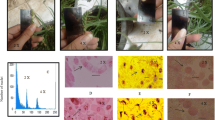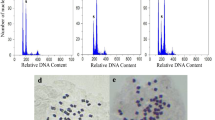Abstract
Echinacea purpurea (L.) is one of the important medicinal plant species. To obtain the tetraploid plants of Echinacea purpurea with improved medicinal qualities, the root tips of two true leaves seedlings were imbibed in 0.25 % (w/v) colchicine solution for 24, 48, 72, 96 and 168 h. The ploidy level of plants was determined by chromosome counting of root tip cells, and confirmed by flow cytometric analysis. Tetraploid induction occurred in seedlings treated for 24, 48 and 72 h at colchicine solution. The morphological, physiological, cytological, and phytochemical characteristics of diploid and colchicine-induced tetraploid plants were compared. Results indicated that tetraploid plants had considerable larger stomata, pollen grain, seed and flower. Moreover, chloroplast number in guard cells, amount of chlorophyll (a, b, and a + b), carotenoids as well as width and thickness of leaves were increased in tetraploids. However, stomata frequency, leaf index, plant height, and quantum efficiency of photosystem II in tetraploid were lower than diploid plants. High-performance liquid chromatography analysis showed that leaves of the tetraploid plants had more cichoric acid (45 %) and chlorogenic acid (71 %) than diploid plants. It was concluded that morphological and physiological characteristics can be used as useful parameters for preliminary screening of putative tetraploids in this species.









Similar content being viewed by others
Abbreviations
- CADs:
-
Caffeic acid derivatives
- DAPI:
-
4′,6-Diamidino-2-phenylindole
- DW:
-
Dry weight
- FCM:
-
Flow cytometry
- HPLC:
-
High-performance liquid chromatography
- MS:
-
Murashige and Skoog
- SE:
-
Standard error
References
Adaniya S, Shira D (2001) In vitro induction of tetraploid ginger (Zinger officinalis Roscoe) and its pollen fertility and germinability. Sci Hortic 88:277–287
Arnon D (1949) Copper enzymes in isolated chloroplasts polyphenoloxidase in Beta vulgaris. Plant Physiol 24:1–15
Barrett B (2003) Medicinal properties of Echinacea: a critical review. Phytomedicine 10(1):66–86
Bauer R (2000) Chemistry, pharmacology and clinical applications of Echinacea products. In: Mazza G, Oomah B (eds) Herbs, botanicals and teas. Technomic Publishing Company, Lancaster, pp 45–73
Berkov S, Philipov S (2002) Alkaloid production in diploid and autotetraploid plants of Datura stramonium. Pharma Biol 40:617–621
Bouvier L, Pillon FR, Lespinasse Y (1994) Oryzalin as an efficient agent for chromosome doubling of haploid apple shoots in vitro. Plant Breed 113:343–346
Chakraborti SP, Vijayan K, Roy BN, Qadri SMH (1998) In vitro induction of tetraploidy in mulberry (Morus alba L.). Plant Cell Rep 17:799–803
Chen LL, Gao SL (2007) In vitro tetraploid induction and generation of tetraploids from mixoploids in Astragalus membranaceus. Sci Hortic 112:339–344
Choffe KL, Murch SJ, Saxena PK (2000) Regeneration of Echinacea purpurea: induction of root organogenesis from hypocotyl and cotyledon explants. Plant Cell Tiss Organ Cult 62:227–234
Dhooghe E, Van Laere K, Eeckhaut T, Leus L, Van Huylenbroeck J (2011) Mitotic chromosome doubling of plant tissues in vitro. Plant Cell Tiss Organ Cult 104:359–373
Gao SL, Zhu DN, Cai ZH, Xu DR (1996) Autotetraploid plants from colchicine treated bud culture of Salvia miltiorrhiza Bge. Plant Cell Tiss Organ Cult 47:73–77
Gonzalez LDJ, Weathers PJ (2003) Tetraploid Artemisia annua hairy roots produce more artemisin than diploids. Plant Cell Rep 21:809–811
Kermani MJ, Sarasan V, Roberts AV, Yokoya K, Wentworth J, Sieber VK (2003) Oryzalin-induced chromosome doubling in Rosa and its effect on plant morphology and pollen viability. Theor Appl Genet 107:1195–1200
Khazaei H, Mohammady S, Zaharieva M, Monneveux P (2009) Carbon isotope discrimination and water use efficiency in Iranian diploid, tetraploid and hexaploid wheats grown under well-watered conditions. Genet Resour Crop Evol 56:105–114
Khosravi P, Kermani MJ, Nematzadeh GA, Bihamta MR, Yokoya K (2008) Role of mitotic inhibitors and genotype on chromosome doubling of Rosa. Euphytica 160:267–275
Knight CA, Molinari NA, Petrove DA (2005) The large genome constraint hypothesis: evolution, ecology and phenotype. Ann Bot (Lond) 95:177–190
Koul S, Sambyal M, Kitchlu SK, Bakshi SK, Kaul MK (2010) Development, micropropagation and characterization of colchiploid of Echinacea purpurea (L.) Moench. Indian J Biotech 9:221–224
Lehrer JM, Brand MH, Lubell JD (2008) Induction of tetraploidy in meristematically active seeds of Japanese barberry (Berberis thunbergii var. Atropurpurea) through exposure to colchicine and oryzalin. Sci Hortic 119:67–71
Li TSC (1998) Echinacea: cultivation and medicinal value. HortTechnology 8:122–129
Lichtenthaler HK, Wellburn AR (1983) Determinations of total carotenoids and chlorophylls a and b of leaf extracts in different solvents. Biochem Soc Trans 11:591–592
Lin Z, Neamati N, Zhao H, Kiryu Y, Turpin JA, Aberham C, Strebel K, Kohn K, Wityrouw M, Pannecouque C, Debyser Z, De Clercq E, Rice WG, Pommier Y, Burke RT (1999) Cichoric acid analogues as HIV-1 integrase inhibitors. J Med Chem 42:1401–1414
Majdi M, Karimzadeh G, Malboobi MA, Omidbaigi R, Mirzaghaderi G (2010) Induction of tetraploidy to feverfew (Tanacetum parthenium Schulz-Bip.): morphological, physiological, cytological, and phytochemical changes. HortScience 45(1):16–21
McGregor RL (1968) The taxonomy of the genus Echinacea (Compositae). Univ Kansas Sci Bull 48:113–142
Murashige T, Skoog FA (1962) A revised medium for rapid growth and bioassays with tobacco tissue cultures. Physiol Plant 15:473–497
Nilanthi D, Chen XL, Zhao FC, Yang YS, Wu H (2009) Induction of tetraploids from petiole explants through colchicine treatments in Echinacea purpurea L. J Biomed Biotech. doi:10.1155/2009/343485
Omidbaigi R, Mirzaeea M, Hassani ME, Sedghi-Moghadam M (2010) Induction and identification of polyploidy in basil (Ocimum basilicum L.) medicinal plant by colchicines treatment. Int J Plant Prod 4(2):87–98
Oquist G, Wass R (1988) A portable, microprocessor operated instrument for measuring chlorophyll fluorescence kinetics in stress physiology. Physiol Plant 73:211–217
Pan ZG, Liu CZ, Zobayed SMA, Saxena PK (2004) Plant regeneration from mesophyll protoplasts of Echinacea purpurea. Plant Cell Tiss Organ Cult 77:251–255
Pour Mohammadi P, Moieni A, Ebrahimi A, Javidfar F (2012) Doubled haploid plants following colchicine treatment of microspore-derived embryos of oilseed rape (Brassica napus L.). Plant Cell Tiss Organ Cult 108(2):251–256
Pugh ND, Tamta H, Balachandran P, Wu X, Howell J, Dayan FE, Pasco DS (2008) The majority of in vitro macrophage activation exhibited by extracts of some immune enhancing botanicals is due to bacterial lipoproteins and polysaccharides. Int Immunopharmacol 8(7):1023–1032
Qu L, Chen Y, Wang X, Scalzo R, Davis J (2005) Patterns of variation in alkamides and cichoric acid in roots and aboveground parts of Echinacea purpurea (L.) Moench. HortScience 40:1239–1242
Shao J, Chen C, Deng X (2003) In vitro induction of tetraploid in pomegranate (Punica granatum). Plant Cell Tiss Organ Cult 75:241–246
Sikdar AK, Jolly MS (1994) Induced polyploidy in mulberry (Morus spp.): induction of tetraploids. Sericologia 34:105–116
Takamura T, Miyajima I (1996) Colchicine induced tetraploids in yellow-cyclamens and their characteristics. Sci Hortic 65:305–312
Tamta H, Pugh ND, Balachandran P, Moraes R, Sumiyanto J, Pasco DS (2008) Variability in in vitro macrophage activation by commercially diverse bulk Echinacea plant material is predominantly due to bacterial lipoproteins and lipopolysaccharides. J Agric Food Chem 56(22):10552–10556
Tang ZQ, Chen DL, Song ZJ, He YC, Cai DT (2010) In vitro induction and identification of tetraploid plants of Paulownia tomentosa. Plant Cell Tiss Organ Cult 102:213–220
Thao NTP, Ureshino K, Miyajima I, Ozaki Y, Okubo H (2003) Induction of tetraploid in ornamental Alocasia through colchicine and oryzalin treatments. Plant Cell Tiss Organ Cult 72:19–25
Ye YM, Tong J, Shi XP, Yuan W, Li GR (2010) Morphological and cytological studies of diploid and colchicines-induced tetraploid lines of crape myrtle (Lagerstroemia indica L.). Sci Hortic 124:95–101
Yokoya K, Roberts AV, Mottley J, Lewis R, Brandham PE (2000) Nuclear DNA amounts in roses. Ann Bot 85:554–561
Zhang XY, Hu CG, Yao JL (2010) Tetraploidization of diploid Dioscorea results in activation of the antioxidant defense system and increased heat tolerance. J Plant Physiol 167:88–94
Author information
Authors and Affiliations
Corresponding author
Additional information
Communicated by B. Zheng.
Rights and permissions
About this article
Cite this article
Abdoli, M., Moieni, A. & Naghdi Badi, H. Morphological, physiological, cytological and phytochemical studies in diploid and colchicine-induced tetraploid plants of Echinacea purpurea (L.). Acta Physiol Plant 35, 2075–2083 (2013). https://doi.org/10.1007/s11738-013-1242-9
Received:
Revised:
Accepted:
Published:
Issue Date:
DOI: https://doi.org/10.1007/s11738-013-1242-9




